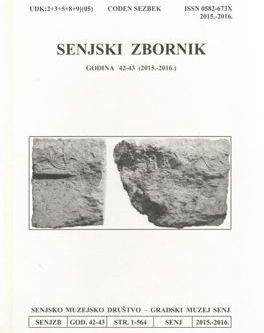Senjska ploča II. (neispisani kameni predložak)
Senj Tablet II (unwritten stone template)
Author(s): Tomislav GalovićSubject(s): Archaeology, Regional Geography, Local History / Microhistory, 6th to 12th Centuries
Published by: Senjsko muzejsko društvo i Gradski muzej Senj
Keywords: Senj tablet; Senj tablet II; Baška tablet; jurandvor fragments; Nehaj fortress; glagolitic epigraphy; Middle Ages; Early Modern Age;
Summary/Abstract: At the end of 2009, during restoration and conservation works on the eastern shell of the Nehaj fortress (under the leadership of Blaženka Ljubović, the director of the Senj Town Museum), on the first floor in the outer last part of the loophole, two new stone fragments were found with an identical border, i.e. the identical plant ornamentation which appears on the Senj and Baška tablets. The dimensions of the fragments are 36x45x12 cm and 35-55x45x12 cm, and they were found with their face built into the wall of the loophole. The two newly-found fragments were located built into the complex of the Nehaj fortress and we are inclined to believe that this happened upon the building of the fortress, therefore in the period of 1551 to 1558. At that time upon the orders of Senj’s Captain Ivan Lenković, and for the needs of the construction of the fortress, all the public and church buildings outside the walled town of Senj were demolished. What kind of initial function the two found fragments had, by an analogy with the Baška and Senj tablets, we can, without hesitation, say that they were originally parts of a former single chancel panel of a church rail. On the first fragment – below the border – a field reserved for carving inscriptions is clearly visible. It is completely empty and contains no writing. On the second fragment the inscription field is ruined and very deformed. We could not even determine a possible inscription or individual grapheme on it. Therefore, we are inclined to believe that both fragments are on the whole uninscribed (or unfinished) stone templates, i.e. partition panels (pluteus) of a church rail (saeptum) which divided the space for the clergy (around the altar) from the church nave for the faithful, and was an integral part of the stone furniture of a Senj church building located outside the town walls and used for the construction of the Nehaj fortress in the 16th century. The Benedictine Church/Abbey of St George whose foundations were in fact excavated in Nehaj presumed this possible. As the relationship between the Baška tablet and the Jurandvor fragments has been established, it is therefore also worth placing a relationship between the Senj tablet and the two newly-found fragments. Therefore, we can also date them to the time of the Senj tablet, i.e. the beginning of the 12th century. We leave the defining however of the masonry workshops and the so-called Master of the glagolitic chancel panel – in whose work can be included the newly-found fragments, then the Senj tablet, Baška tablet and the Jurandvor fragments - to art historians to debate for now. Today both fragments are stored in the Senj Town Museum, and inventoried in the museum’s M++ program in the Collection of Stone Monuments under the number ZKS 32 ‘a’ and ‘b’. The fragments are on display in the Glagolitic Heritage of Senj Collection in the Senj Town Museum. In this place and upon this occasion (although they have no glagolitic grapheme) we have suggested the title of Senj tablet II, because they belong to the same cultural-intellectual circle as that of the Senj tablet, as well as the Baška tablet and its Jurandvor fragments.
Journal: Senjski zbornik - prilozi za geografiju, etnologiju, gospodarstvo, povijest i kulturu
- Issue Year: 43/2015
- Issue No: 1
- Page Range: 327-340
- Page Count: 14
- Language: Croatian

